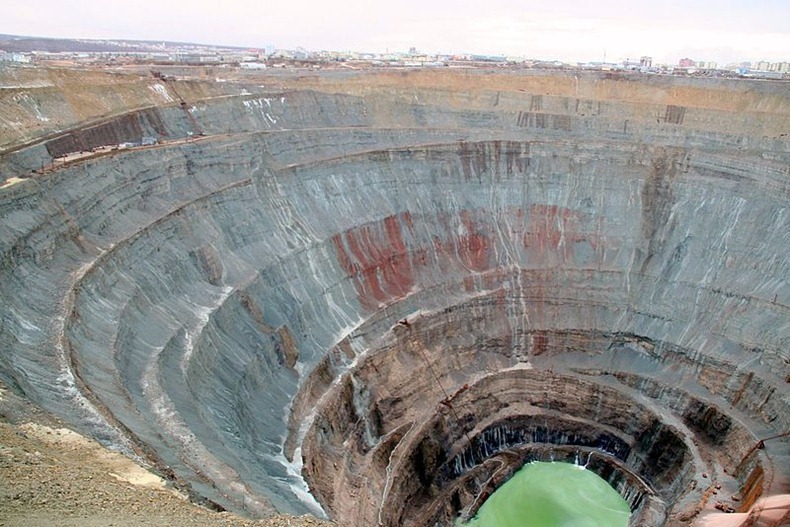Mir Mine also called Mirny Mine is a former open pit diamond mine located in Mirny, Eastern Siberia, Russia. At the time of its closing in 2004, the mine was 525 meters deep and 1,200 meters across making it the second largest excavated hole in the world, after Bingham Canyon Mine. The hole is so big that airspace above the mine is closed for helicopters because of incidents in which they were sucked in by the downward air flow.
Mining began on 1957, in extremely harsh climate conditions. The Siberian winter lasted seven months which froze the ground, making it hard to mine. During the brief summer months, permafrost would become mud turning the entire mining operation into a land of sludge. Buildings had to be raised on piles, so that they would not sink. The main processing plant had to be built on better ground, found 20 km away from the mine. The winter temperatures were so low that car tires and steel would shatter and oil would freeze. During the winter, workers used jet engines to burn through the layer of permafrost or blasted it with dynamite to get access to the underlying kimberlite. The entire mine had to be covered at night to prevent the machinery from freezing.
During its peak years of operation, the mine produced 10 million carats of diamond per year, of which a relatively high fraction (20%) were of gem quality. This worried De Beers company, which at that time was distributing most of the world's diamonds. The company was forced to buy larger and larger shipments of high-quality Russian diamonds in order to control the market price. For De Beers, Mir was a puzzling mystery. The mine’s enormous output was not consistent with the relatively small size of the mine. By the 1970s, when the Mir should have been producing smaller and smaller quantities of diamonds, the Soviets were producing an increasing quantity of gem diamonds. Finally, in 1976, De Beers requested a tour of the Mir mine to satisfy their curiosity. Permission was granted, but the Russians kept delaying the visit and by the time the team of delegates reached the Mir mine, their visas were about to expire, so that they could only have 20 minutes at the Mir mine. The visit did little to shed light on the mystery of the Mir’s diamond production.
After the collapse of the USSR, in the 1990s, the mine was operated by a few local companies until 2004 when the mine was permanently closed.






















Amazing
ReplyDeleteHow does one get down to the bottom? Mind boggling...
ReplyDeleteThe spiral road that circles the inside of the cone shape of the mine
DeleteConsidering I'm afraid of heights(or in this case depths) that's one of the scariest things I've ever seen. I'll probably have nightmares about falling in tonight.
ReplyDeleteMy thoughts EXACTLY
DeleteWould make a hell of a lake
ReplyDeleteI agree
DeleteLand fill.
ReplyDeleteWhat was done with all the slag (non-diamond material) which was excavated from the mine?
ReplyDeleteexactly.. wondering how long would take to fill it ..
DeleteSimply amazing. Curious to know the secrets behind its production though...
ReplyDeletesteel shatters? This sounds like liquid nitrogen, not Siberia. In Northern Canada we have low temperatures but our steel doesn't shatter.
ReplyDeleteAnd covering the whole mine at night? That's one mighty big tarp, a mile buya a mile. I wonder how they put it in place. Oh, I know, HELICOPTERS -- a whole bunch of them. Oh. no, they're prohibited . . . .
Maybe Putin and his friend Rasputin do it.
Well, not exactly liquid nitrogen, but the mine is in Yakutia, a frigging coldest place on the Earth after the Antarctic — the frosts of -50°C are common there, and -60°C isn't unheard of.
DeleteIn fact, this is colder than parts of Mars, lol, and well cold enough to bring non-specialized grades of steel to shattering point. Much of the low-temperature materials research were fueled by the needs of the Eastern Siberia development.
And tarps were used in the Fifties, when this research was in its infancy, and the mine was much, much smaller, and indeed could be covered over.
Hey, that's 59km away from my friend Kimberly's relatives land. They produce liquid materials from the lake in the summer.
ReplyDeleteDo people still live there. It may not sound like much of an intelligent question, but there would be no point in moving an entire city of people unless they have no work there, which they would have needed for selling daily necessities.
ReplyDeleteyes, I actually know a guy that is from there, and his family still lives there.
DeleteIt really makes me think about Junji Ito's manga called Uzumaki. Google search it and you'll see what I mean.
ReplyDeleteFrom what the story said about the high amount of gem quality stones and the fact that they wanted to keep DeBeers (their biggest customer) from touring the mine, I would be very suspect of the stones that are known to have come out of this mine. It would be just like the Russians to craft a bunch of high quality Cubic Zirconia and pass it off as diamonds.
ReplyDeleteI was wondering the same thing, what is the possibility that say 40% of the mines output are them Russian made perfect diamonds, they seemed to be very good at it.
DeleteWhat was the main reason for the abandoning of the mine? I read somewhere that it could function for another 50 years. So why was it shut down. Please answer
ReplyDeleteIt's been reopened
Delete